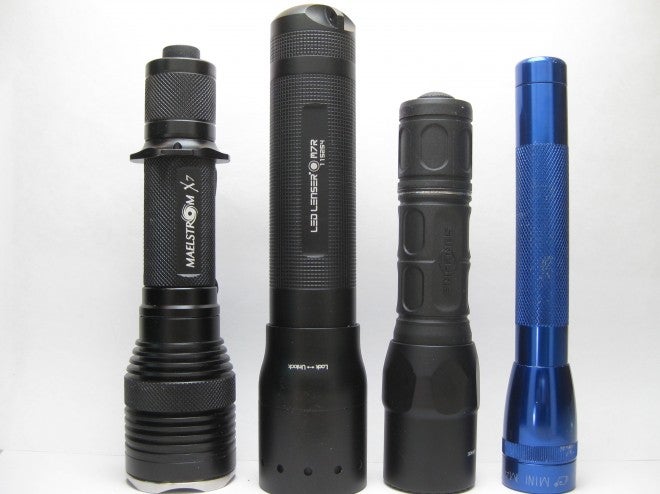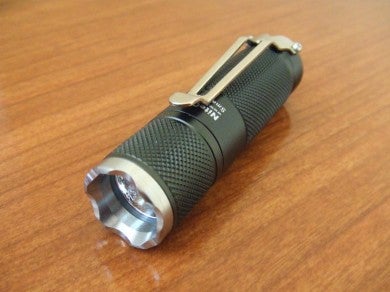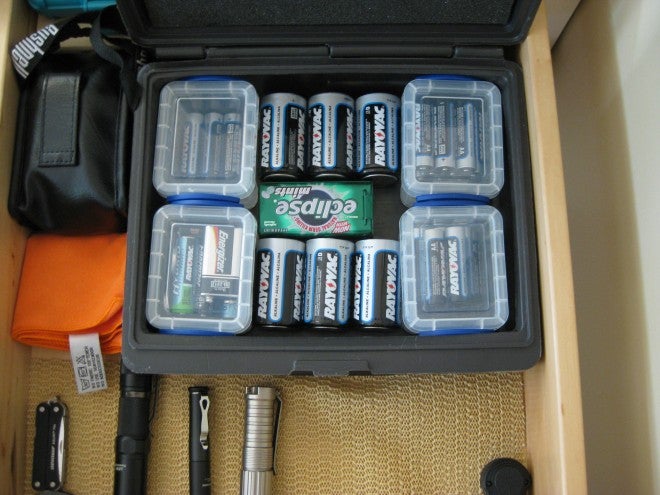Five flashlight tips for emergencies
Tony Sculimbrene 08.26.13

In 2008, New England was swamped by an ice storm in the first half of December. It was the longest time I have been without power in my life, and it was by far the most widespread power outage I have ever been in. Living in Ohio before New England, I was used to tornado damage, but it never took out power for a week. The situation was very bad, but we were prepared. We had firewood, a gas stove, and a kerosene heater. Nonetheless, given the time of year, our biggest battle was with the setting sun. Surprisingly, the combination of two fireplaces, a stove, and the kerosene heater kept the house at a toasty 55 degrees, even at night. Since that storm we have lost power two other times for more than a day and each time, again, it is the setting sun that is our enemy.
The ability to get things cleared and ready for normal (such as removing limbs blocking our electrical box) required me to work beyond the scant hours of daylight we were given. Then, after that, negotiating a dark house for dinner and an icy shower again required light. Fortunately, I am hopeless addicted to flashlights, so light was not an issue. The picture above represents a small portion of the twenty or so lights I had at the ready:
Tip #1: Get a lantern
It is surprising how effective a good lantern can be at illuminating a dark room. Sure, most of them are garbage (though I have had good experience with this design, sold under multiple brand names), but even a cheap lantern can throw enough light around a large space to get you around that coffee table that seems to have a vendetta against your knee caps. Really, the lantern is not for lighting up things to work on or see, but to give you just enough light to navigate in the dark. They are all flood and no throw, so you will need to supplement a lantern with other lighting sources. One caveat: skip the high end ones found in tool kits (or sold separately like this number from Festool); they are much nicer but almost all of them require a rechargeable battery pack, meaning once its dead, your done with light.
A corollary to this tip is get a headlamp. Yes, I know they are tremendously dorky (and I mean TREMENDOUSLY dorky), but in the middle of a crisis, when you need to saw through a branch in the middle of the night to get your car out of the driveway, fashion can’t be your biggest concern. There are too many tasks that need both hands to not have a headlamp just in case. You can get one at the Big Box stores and they are okay, but for only a few dollars more you can get a genuinely great one from Zebralight (like this; the Hi CRI output will help distinguish colors better). The ZL light will be good enough to use in other situations whereas the Big Box one will likely only be useful in emergencies.
Tip #2: Tailstanding required
You have a lantern (and Travel Scrabble, which my wife and I played each night before bed to help normalize the situation) and a headlamp. Even then, it is probably most practical to rely on a conventional EDC light for general tasks and to have on your person, just in case. Most headlamps don’t have good throw and a lantern, by definition, has none, so if you need to light something up far away (such as a bump in the night), a good EDC light will work wonders. Plus, in a pinch a good EDC light can do everything the lantern and headlamp can.
One thing that is absolutely essential though is the ability to tailstand. This allows you to shine the light on the ceiling and, thanks to the reflective capacity of white ceiling paint, illuminate the entire room. You can use this as a lantern substitute or, if your light is good enough, as a true and accurate wired light replacement, allowing you to do detail work when the crappy and heavily artifacted light of a lantern wouldn’t permit.
In 2008, I had a hell of a time getting kerosene into a nozzle on the tank (we bought the heater in the middle of the 5 day period so it was totally new to me). The lantern just didn’t put out enough quality light for me to see what I was doing, and shining my EDC light would have blown out my vision. Thanks to the ability to tailstand I could do all of this with ease. Another test: of all the gadgety things about modern flashlights, this is the only feature my wife knows by name or cares about at all.
Tip #3: Runtime Trumps Lumens
At the time of the storm my EDC light was my then brand new Nitecore EX10:
This was my first $100+ light and it was totally pimped out with a clip and the Ti bezel. I had received it for my birthday less than two weeks before the big storm. One thing that made this light especially great was its really long (for the time) runtimes on low. It takes very little light to get around. 30 lumens is actually quite bright, and more than enough for most tasks. I always want the option of really punching up the photons, but runtime is more important.
In the two subsequent storms where we lost power I was equipped with one of my favorite lights of all time, the Muyshondt Aeon, and it is a runtime champ hitting 30 lumens for roughly 40 hours on a single CR2 cell. That much light for that long basically meant I was never without illumination when I needed it (the Aeon’s size also helped me carry it everywhere with ease). The Aeon Mk. II is even better, with a moonlight low of 5 lumens for even longer and the still great 30 lumens for 40 hours as a medium output level.
It comes down to this–some light is better than no light, so when you can trade 70 or so lumens away for extra runtime, in an emergency you should always do that.
Tip #4: Diversify Battery Types
This is my battery drawer, about two years ago. I am, perhaps you can guess, a little obsessive.
But the point is this–in an emergency having lights in multiple battery formats is a good thing.
The storm hit on a Friday and we do our grocery shopping on a Saturday. We assumed that everything would be closed and mostly it was. But one grocery store had an emergency generator and we got there around 8 AM. It was buzzing with people and the panic gave everything a slightly zombie movie feel (or maybe it was the lack of lighting in the store). We went straight for fire supplies (I had yet to cut up limbs from trees for firewood) and knowing I had that cache of batteries, left them for the end of the shopping trip. By the time we arrived at the battery section all of the AA and AAA batteries were gone. There were however some D cells and “camera batteries” as non-flashaholics call them. Looking through I found a few CR123a cells. They were incredibly overpriced at $8 a piece, but something is better than nothing.
It was an odd example of why common batteries might not necessarily be the most readily available cells. By having a collection of lights that run on various batteries you can not only take advantage of different batteries’ different properties, but you can also increase your chances of find cells that will power your lights even when there is a run on batteries.
Tip #5: Keep it Simple
If you are fan of modern flashlights, the daunting Morse-code like UIs probably don’t bother you, but in an emergency it’s better to keep things simple. There are two good reasons for this. First, if things are really bad and not just uncomfortable, stress will make it hard to operate lights that require fine motor skills. Second, if you are with someone else, you might have to give them a light too and you want them to be able to operate it without instruction. An emergency is not a good time for a crash course on modern flashlight UI.
I really like selector ring UIs because they are so intuitive: turn for light, turn more for more light. The M11R from Sunwayman and the RRT 01 from JetBeam have selector ring only UIs and they are excellent. Additionally, the previously referenced runtime king, the Aeon, has a staged twisty (meaning you can twist in one direction to get multiple outputs instead of twisting the light on and off to switch between modes). Clickies can be a challenge as the timing necessary to switch modes can sometimes cause inexperienced users to turn lights on and off by accident.
Conclusion
With a little planning you can really make your flashlight obsession work for you in a crisis. You can lend out lights to folks that need them (after our power was restored I brought in most of my lights for folks at work that didn’t have power yet; all 39 of them were grateful). You can get lots of crucial work done. You can do things to keep your spirits up (triple word score on CONQUEST anyone?). And perhaps you can prove to your significant other that this little addiction isn’t such a bad thing.
Here are some particularly good lights for bad times:
- The aforementioned Zebralight H51c: The Hi CRI emitter will help make colors clearer and the ability to run long and bright on a single AA should help in the event that the only batteries you have are those at the corner convenience store or ones you have to pilfer from a TV remote.
- EagleTac TX25C2: It has a bleeding edge emitter with insane outputs and great runtimes on a rechargeable 18650, but it can also run on 2xCR123a batteries. It is compact enough to carry in your pocket, but has a head big enough for good throw. It tailstands like its glued to a surface and has a simple no fuss, no muss UI.
- A collapsible battery operated lantern.
- An ultra long runtime light. The Mark II mentioned above is good, but it is very expensive and sold out. A runtime king replacement (a duke to the Mark II’s king, if you will) is one of the Mini Quarks from 47s. They have very good highs and excellent runtimes on low. In particular I like the Mini 123A.
Addendum: A cautionary word about “self-powered flashlights”
You might be wondering why I didn’t cover any of the crank, shake, or solar powered lights, which seem perfect for an emergency. The reason I didn’t is because in the many years that I have been buying and using flashlights, all of them were garbage. Most use a cell that is recharged by cranking, shaking, etc. and eventually that cell can no longer take a charge. When that happens you are left with something worse than a broken flashlight in an emergency — you are left with a flashlight that you might be counting on, but will never work. Until the technology improves or someone decides to really pay attention to what they are doing with these “self-powered” lights, just avoid them. You never know when they will die and you’d be left with a useless hunk of plastic.

